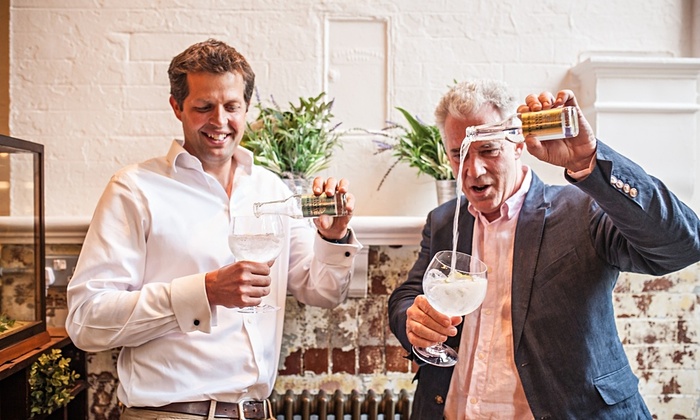
#228
A TONIC BOMB
28 Sep 2015 By David Fuhrmann-Lim
The men who saved the G&T: Challenging Schweppes wasn’t easy, but Fever-Tree has struck gold.
By Ed Cumming (The Guardian)
Before his death in 2011, Richard Hamilton went from enfant terrible to éminence grise of British pop art, famous for his collages such as Just What is it That Makes Today’s Homes So Different, So Appealing? Along the way he acquired plenty of other creative friends, including El Bulli chef Ferran Adrià, molecular gastronome and the Abraham to Heston Blumenthal’s Isaac. Gin and tonic was Hamilton’s favourite drink, and he would mix one as a ritual whenever he finished a new work. A bottle of Beefeater appears in one of his prints alongside two bottles of Schweppes tonic water. For the whole 20th century, since the company started making it in 1873, Schweppes and tonic water had been synonymous.
But in Waitrose one day – so the story goes – Hamilton found a new tonic, Fever-Tree. It came in glass bottles rather than a can or a plastic bottle. It was much more expensive than Schweppes, but the flavour more than made up for it. In fact it tasted so good that the artist was moved to send a bottle to his friend Ferran, out in Catalonia. A short while afterwards, Fever-Tree had a request from Adrià’s sommelier asking for a whole crate. The chef wanted to use a liquid nitrogen-cooled granita of Fever-Tree tonic in one of his dishes.
“Our arrival in the Spanish market, via El Bulli, was fortuitious,” says Tim Warrillow, one of the founders of Fever-Tree. It’s something of an understatement. Not only was the brand thrust into one of the world’s best restaurants (it has since been stocked by seven of the world’s top 10), but it was in on the ground floor of what would become an enormous Spanish “gin-tonic” craze.
Between 2008 and 2013, Spanish gin consumption grew by an average of more than 15% per year, and they are the highest consumers per capita in Europe. Spanish bars often have separate gin-tonic menus, with the drinks served over piles of ice in large fishbowl glasses.

Spanish tip: chef Ferran Adrià used a liquid nitrogen-cooled granita of Fever-Tree tonic in one of his dishes. Photograph: Murdo Macleod for the Observer
For Fever-Tree it was a pivotal moment, although it was already making inroads. Warrillow, a former ad man, and Rolls, who had previously reinvigorated the venerable Plymouth Gin brand, founded the company to challenge Schweppes’s dominance of the mixers market, starting with tonic water. It was a difficult proposition because of the Schweppes monopoly, but this was also exactly what made it appealing.
“We noticed how commoditised tonic water had become in the hands of this big conglomerate,” says Warrillow. “Schweppes had no competition so it focused on cost-cutting, and this large category had become really poor quality.”
But tonic water is in many ways an ideal consumer product. It keeps for a long time, but not forever, and it is relatively easy to transport and store. From 2003 onwards, Warrillow and Rolls went about rebuilding tonic water from the ground up. The first bottles appeared on shelves in 2005.
“Our idea was to approach it in a totally different way,” says Warrillow. “We went off round the world to find the best ingredients we could.” Their quinine was from the Congo, their bitter orange from Tanzania, lemons from Sicily. “It reminded people that there really are ingredients in tonic water. And then we spent a lot of time talking to chefs, barmen and journalists to explain how important the mixer is. A gin and tonic is three parts mixer to one part spirit, so there’s no point having a good gin if the tonic isn’t right.”
Three-quarters of Fever-Tree’s revenue comes from outside the UK, with some surprising areas featuring. Who knew that Colombia was so keen on gin? Ten years on, tonic has also made Rolls and Warrillow extremely rich. In 2014 Fever-Tree floated on the stock market at a valuation of £154m. Other premium mixers have entered the market, but Fever-Tree dominates.
“Fever-Tree markets itself quite aggressively, but it had to. It was trying to persuade people not to purchase Schweppes, which they’d been buying for 100 years,” says Olivia Williams, the author of Gin, Glorious Gin, a history of Britain’s long and at times complicated relationship with the drink. The gin revival has been well documented; the tonic resurgence less so. “The cost is justified by the quality of the ingredients,” says Williams, “but the flavour of the fresh quinine is so strong that it’s not necessarily the best tonic for some of the newer, more floral gins, despite what Fever-Tree might like you to think. It’s better with the traditional juniper-heavy gins.”
Read the rest at The Guardian.

You might be interested in...
GIN-GLE ALL THE WAY
Brass Lion Distillery's December-Long Yuletide Celebration Checks All The Right Boxes Of My Grown-Up Christmas List
NEW BEGINNINGS
New Year, New Gins, Isn't That How The Saying Goes? In Any Case, Here Are Three Unique Gins From Three Different Countries That'll Be Your Tonic to The New Year.
MEET CHARMAINE THIO
Excuse Me Miss, Is Your Last Name Thio or Chio? Meet Charmaine Thio, Brand Ambassador for Hendrick's Gin, Southeast Asia.
GIN-GLE ALL THE WAY
NEW BEGINNINGS
MEET CHARMAINE THIO